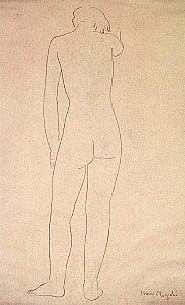An act on the computer is a sleight of hand. The space of the computer is one that contains—and is composed of—nothing but abstract forms, described by the potential of a digital file. When we travel in cyberspace, we travel in a vehicle that does not really move, but merely simulates the act of speeding from place to place, form to form, object to object. Objects in the computer have no matter; they are nothing more than abstraction, potential that may or may not be realized into the physical (meatspace). Form is paramount: there is no matter. In the circuit, the form (or the program that creates it) changes as need demands. In the realm of the circuit, creativity is the sleight of hand that changes how we see and experience reality.
In the sixth century BCE, Pythagoras shifted philosophical inquiry away from the universe's constituent matter to its organization or form. For the ancient Greeks, form gave meaning and substance to matter. Through his mathematical study of music, Pythagoras was led to the notion that number was the first principle of the universe; each object was composed of a particular mathematical formula that organized its matter into form. Scientists later came to discover that the form of who we are is shaped by the genetic code carried by our DNA, which is unique to each of us.

The Big Duck, Long Island, NY

The mushroom, as no other form, had defined the twentieth century
Modernist architecture of the twentieth century, epitomized in the work of Mies van der Rohe, advanced the notion that form followed function. Analysis of the resources and needs of a building dictated its planning and organization and ultimately its physical shape. In the twenty-first century, form has become more determined by function than ever before: automobiles are styled foremost by aerodynamic concerns. Likewise, contemporary communication is driven by speed, efficiency, and economic pressures. The language of an instant message has been reduced to the bare essentials of the letters, without wasting time on grammar, punctuation, or spelling.
- Kazuo Ohn, founder of Butoh
Today, scientists believe that matter is energy, whose arrangement and composition into atomic elements gives structure to the universe. Although Western science once thought that the matter of the universe was solid and unchanging, we now know that it is made up of potentials and possibilities, of unstable and unknown subatomic elements. This is echoed in the virtual world, whose form is composed of no more than zeros and ones, its elements arranged into such things as music or cyber architecture—where a sleight of hand can produce a new perspective. If matter is energy in constant flux, then so, too, are its forms. Creativity is the search for new meanings in abstract forms and its realization in material structure.
We can morph our identities, our appearance, our sexuality, and the very composition of genetic code. Everything is unstable. Images can be radically changed: text is cut and pasted across the Internet; music is likewise sampled, mixed together and constructed from nearly any sound. The distinctions that once separated races, genders, and even the human from the machine, are all blurring. Finally, borders that separated states and political or economic entities are redefined on a daily basis. Previously stable assumptions are now in question. According to Jacques Derrida, the father of deconstruction, the very language we use to construct our notions of the world can be questioned. Nothing is really knowable because the signs that compose language refer to nothing but one another and so there is nothing outside language. This line of thought, which can be taken to an extreme, nevertheless underlines an important attitude. If we question all assumptions and forms, then we create the possibilities for new structures that inflect meaning.
- Alan Kay, Insanely Great
The process of deconstruction can enable the rediscovery of our notion of self. This deconstructed self has replaced what was previously thought to be a unified or stable being. In cyberspace, we become multifaceted and at the same time we disintegrate as we glide through the electronic ether. As we move from one node to the next, we change the space we move through, leaving parts of ourselves at web pages and in chat rooms. Our interaction with people on the Internet changes us, changes them, and ultimately changes the forms of interactions.

Sake bottle, Japan, 1868
Online games present players with an arena for interaction—virtual worlds created by text or images that construct fantasy landscapes, for example. In some of the games, players can interact not only with one another, but also with the landscape of the game itself, as they are enabled to create new maps, characters, and scenarios. Some go so far as to write stories based on the games themselves. In 1996, a Japanese company, Hori Pro, created a virtual persona called Kyoko Date, who recorded a CD, gave interviews and appeared in music videos, although she was nothing more than a virtual construct.

Isamu Noguchi
In the process of continuous change and the evolution of ideas, will we be able to find a stable context? Maybe the answer lies in the Hindu notion that Om, or spiritual energy, is the underlying principle of the universe; it is the container for all of its aspects—time, space, matter, and so on. Yogins attempt to achieve enlightenment by liberating their personhood from matter; that is, to recognize their true condition. There is no stable context in the world we have created. We use form, although we know it temporary and changeable, in order to contain our expression.
